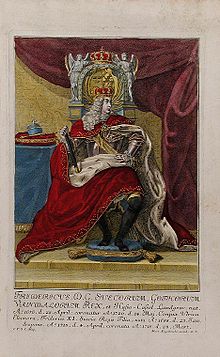
The 1720 Instrument of Government (Swedish: 1720 års regeringsform) adopted on 2 May 1720 by the Riksdag of the Estates (Swedish parliament), was the constitution of the Kingdom of Sweden from 1720 to 1772, and was thus in force for almost the entirety of the period of constitutional monarchy known as the Age of Liberty, having replaced the largely identical Instrument of Government (1719).
The decision to enact a new constitution so soon after the previous one was prompted by the decision of Queen Ulrika Eleonora to abdicate in favour of her husband Frederick of Hesse, who thus became King Frederick I. The Riksdag disapproved of this manoeuvre and suspected Frederick of having ambitions of restoring absolute monarchy, and so in exchange for ratifying his accession as king it forced him to accept a new constitution, which imposed tighter restrictions upon royal power than its predecessor.[1][2] In most respects, however, the 1720 Instrument was identical to that of 1719.[3]
The 1720 Instrument of Government remained in force for fifty years, before being replaced by the 1772 Instrument of Government, which ended the period of constitutionalism and restored absolutism in Sweden.[4]
- ^ Hofpartiet Nordisk familjebok (1909), band 11, s. 933-935
- ^ Hofberg, Herman; Heurlin, Frithiof; Millqvist, Viktor; Rubenson, Olof (1908). Svenskt Biografiskt Handlexikon – Uggleupplagan [Swedish Biographical Dictionary – The Owl Edition] (in Swedish). Vol. 8 (2nd ed.). Stockholm, Sweden: Albert Bonniers Förlag. pp. 1255–1258. OCLC 49695435. Retrieved 1 March 2012.
- ^ Regeringsformen, Nordisk Familjebok (1915) (in Swedish)
- ^ Regeringsformen, Nordisk Familjebok (1915) (in Swedish)
© MMXXIII Rich X Search. We shall prevail. All rights reserved. Rich X Search
